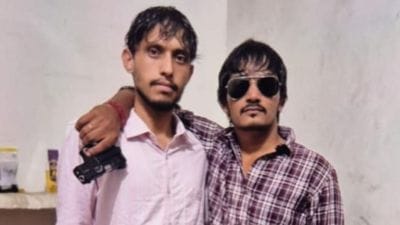From the door of a mausoleum to artwork adorning the wall of a tea shop: How MF Husain left his imprint on Ahmedabad
On the celebrated artist's 110th birth anniversary, owners of shops he frequented along with a long-time collaborator reminisce on their time with M F Husain
 Husain at the saraspur tea stall (Express Photo/Anil Relia)
Husain at the saraspur tea stall (Express Photo/Anil Relia)“Paun mein chappal nahin pehenneka…pehle mere haath milave, phir mere hotel mein jaave, ek chai peeneki aur ek gakhar khaneka, bas! Meine kaha, ‘Husain saab, ek sign toh kar do’; Aur unhone note pe ‘MF Husain’ sign kiya (He would not wear slippers, would shake my hand first, then head to my eatery, have a cup of tea and a gakhar [a thick roti dunked in ghee]. I requested him to sign for me and he did).”
It may have been almost two decades since M F Husain went into exile, and 15 years since his demise, but Khozemabhai Khambhati, who runs a store selling sundry items – from socks and trinkets to tea and biscuits – in the Saraspur area of Ahmedabad remembers the legendary painter’s visits to his modest establishment like it was yesterday.
Around four white tables whose laminated tops have paled, bottles of packaged water, a few loaves of bread, biscuit cartons, and a host of instructions on the walls make up this ‘hotel’ that Husain frequented some 20-25 years ago.
Husain’s main destination, though, was the mausoleum of the Sulaimani spiritual head situated next door.
 Lucky tea stall which Husain frequented (Express photo/Bhupendra Rana)
Lucky tea stall which Husain frequented (Express photo/Bhupendra Rana)
“Husain saab came here and found peace (sukoon),” Salim Sulaimani, one of the custodians of the mausoleum who often met Husain, who would have turned 110 on Wednesday, tells The Indian Express.
Ahmedabad-based art curator Anil Relia, who has a personal collection of Husain’s works, remembers how the duo would stop by at Saraspur, a former textile mill hub in the city, where Husain would get a “long brass key from a custodian and we would go to the mausoleum where on turning the key seven times, each with a clicking sound, the wooden door would open and Husain would go inside and pray as I sat outside”.
Husain designed a door made of silver with gold inscriptions that replaced the wooden one that opens to the mausoleum of Syed Sulaiman Bin Hassan, the spiritual leader of Sulaimani Bohras – the community to which the artist belonged, says Relia.
The spiritual leader’s mausoleum, located in the expansive Mazar-e-Qutbi premise, is just a small part of Husain’s engagement with Ahmedabad.
Relia has editions of Husain’s rare drawings from the 1970s on the old city of Ahmedabad on its monuments like the Teen Darwaza, the iconic Raipur Bhajiya house, the pol neighbourhoods, and the everyday life captured in line art in black ink on paper.
The set of around 20-25 sepia-tone drawings, which remain a part of Husain’s lesser-known works, capture details like the signboard of a readymade cloth store with the footnote in Gujarati: ‘Stitched and full dhotis available’. Another one on the city’s famous bhajiya (pakora) house in Raipur area captures a slogan: ‘Kathor parishramno koi vikalp nathi (there is no substitute for hard work)’ in Gujarati. The one on Panch Hatdi ni pol in old Ahmedabad has the tailor sitting on the sewing machine at ‘Omkar tailoring’ sipping tea from a saucer; signboards of ‘National Cricket Club’ and a yuvak mandal visible from the pol gates, with people going about daily chores — typical to life in the gated neighbourhoods of Ahmedabad. One painting, of a couple on a bullock cart, has a date — 21 November, 1976, even as most of these works bear Husain’s signature in Gujarati.
 One of the mausoleum door that was designed by Husain
One of the mausoleum door that was designed by Husain
“He brought them to me around 2002; the paper, even at that time, had yellowed with age. He wished to compile them in a document that remained unfinished,” says Relia. It was at Relia’s doorstep that Husain’s search for a graphic artist to print the frames of the Madhuri Dixit-starrer Gaja Gamini had ended in the mid-1990s. The film was released in 2000.
Pritzker prize-winning architect Balkrishna Doshi had introduced Husain to Relia, forging a bond that would last a lifetime.
By then, in 1992, the two greats had collaborated to build the Husain-Doshi Gufa adjacent to the CEPT University. Doshi designed the unique underground cave-like mosaic tile-finished structure, compliant with weather conditions of the city, and Husain painted its internal roof and walls with his signature bold and colourful human forms, animal motifs and horses. According to Relia, Husain took a call to rename the gufa to Amdavad-ni-Gufa.
In 1996, the gufa was vandalised by Bajrang Dal activists protesting works of Husain on deities. “He was least worried about the loss of his work as much as he was about the harm to people working at the gufa and asked me to ensure they were taken care of,” Relia tells The Indian Express.
“He was someone who believed in taking everyone along,” says the art collector who took charge of the gufa in 1997.
Some five kilometres away from Saraspur was another favourite haunt of Husain – the Lucky Tea Stall, right opposite the 16th-century Sidi Sayed Mosque known for its stone filigree windows.
Built around a graveyard, this tea stall, whose owner belonged to Kerala, has “tables arranged around 26 graves”, says an employee of 16 years, refusing to identify himself. “Husain came here to have tea, and gave the owner this painting in 2004,” he says, pointing at the artwork.
The busy place now also serves meals in a section that has 24 of the graves, and a neem tree growing from its centre. The tea and maska bun is served in the adjoining section with the remaining two graves, all surrounded by a steel frame.
It was at Relia’s house that Husain decided to paint for the Lucky restaurant owner — the process preserved in a set of photographs that the art curator took. Husain, whom Relia addressed as ‘Baba’ (father) would frequent Lucky along with Doshi, another well-known artist, Amit Ambalal, and others during those days, recalls Relia.
The maternal side of Husain’s family was from Sidhpur in Patan and Husain began coming to Ahmedabad as a six-year-old. He was sent to a madrassa in Vadodara to study but then took to painting.
Awarded a Padma Vibhushan in 1991, Husain went into exile in 2006, following the controversy over his work, and spent time between Qatar, Dubai and London. When he passed away on June 9, 2011, Relia, who was in London working on a project with him, bid his final adieu to the celebrated artist at the Brookwood Cemetery in Surrey, London.








